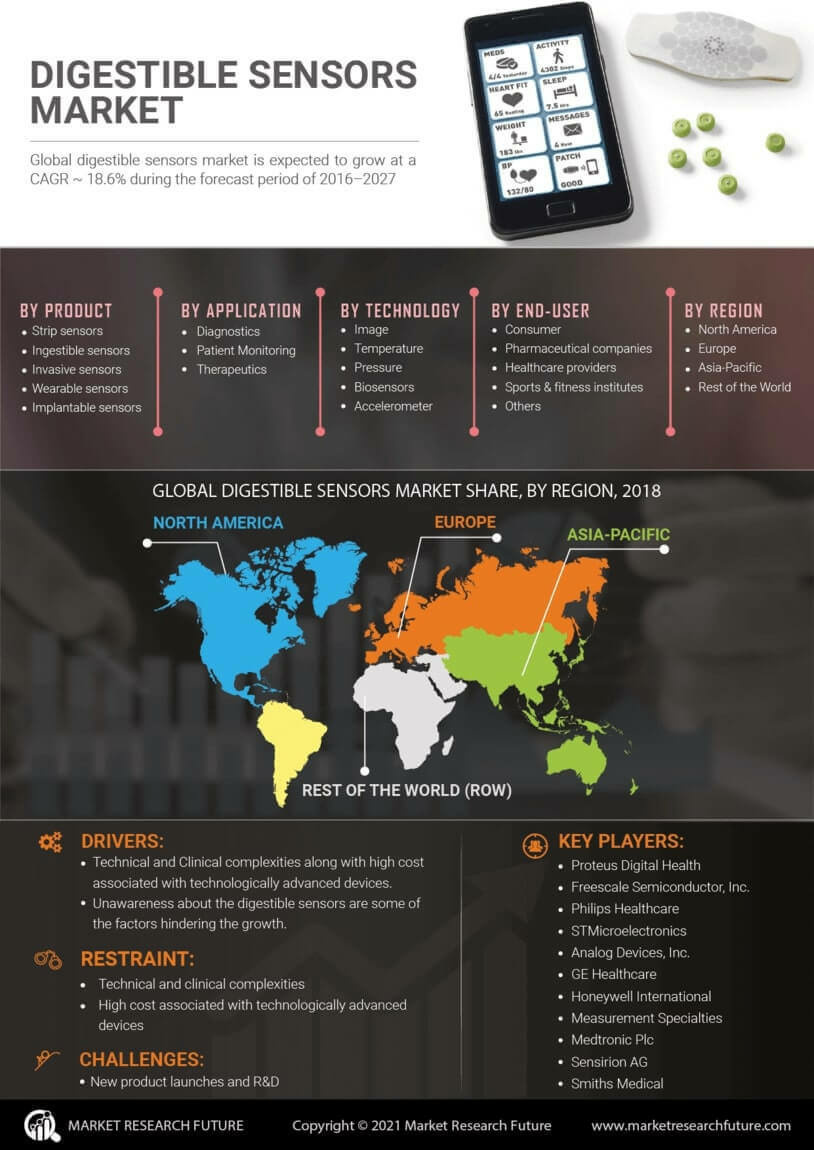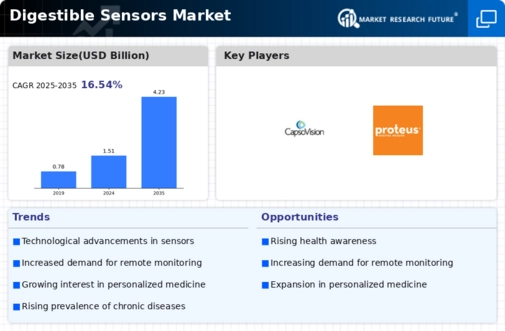Market Growth Projections
The Global Digestible Sensors Market Industry is poised for substantial growth, with projections indicating a market size of 1.51 USD Billion in 2024 and an anticipated increase to 4.23 USD Billion by 2035. This growth trajectory suggests a compound annual growth rate of 9.81% from 2025 to 2035. Factors contributing to this expansion include advancements in sensor technology, increasing demand for remote patient monitoring, and a growing focus on preventive healthcare. The market's evolution reflects broader trends in the healthcare sector, emphasizing the importance of innovative solutions for improving patient outcomes and enhancing the efficiency of healthcare delivery.
Growing Focus on Preventive Healthcare
The Global Digestible Sensors Market Industry is witnessing a paradigm shift towards preventive healthcare. As healthcare systems globally emphasize early detection and prevention of diseases, digestible sensors emerge as valuable tools for proactive health monitoring. These sensors facilitate the continuous assessment of physiological parameters, enabling individuals to make informed lifestyle choices. This trend aligns with the broader movement towards personalized medicine, where treatments are tailored to individual needs. The increasing awareness of health and wellness among consumers is expected to drive the adoption of digestible sensors, further expanding the market's potential.
Rising Demand for Remote Patient Monitoring
The Global Digestible Sensors Market Industry experiences a notable surge in demand for remote patient monitoring solutions. As healthcare systems increasingly prioritize patient-centric care, digestible sensors offer a non-invasive method to monitor vital health metrics in real-time. This trend is particularly relevant in chronic disease management, where continuous monitoring can lead to timely interventions. The market is projected to reach 1.51 USD Billion in 2024, reflecting a growing acceptance of these technologies. Furthermore, the integration of digestible sensors into telehealth platforms enhances patient engagement and adherence, potentially reducing healthcare costs and improving outcomes.
Technological Advancements in Sensor Design
Technological advancements play a pivotal role in shaping the Global Digestible Sensors Market Industry. Innovations in materials science and miniaturization techniques have led to the development of more sophisticated and reliable sensors. These advancements enable the creation of sensors that can transmit data wirelessly, providing healthcare professionals with immediate access to patient information. For instance, the introduction of biocompatible materials enhances the safety and efficacy of these devices. As a result, the market is expected to grow significantly, with projections indicating a rise to 4.23 USD Billion by 2035, driven by continuous improvements in sensor technology.
Regulatory Support and Standardization Efforts
Regulatory support and standardization efforts are crucial for the growth of the Global Digestible Sensors Market Industry. Governments and health organizations are increasingly recognizing the potential of digestible sensors in enhancing patient care. Initiatives aimed at establishing guidelines for the safe and effective use of these technologies foster confidence among healthcare providers and patients alike. Moreover, standardization efforts ensure interoperability between devices, facilitating data sharing and integration into existing healthcare systems. As regulatory frameworks evolve, they are likely to create a conducive environment for innovation and investment in the digestible sensors market.
Increasing Prevalence of Gastrointestinal Disorders
The Global Digestible Sensors Market Industry is significantly influenced by the rising prevalence of gastrointestinal disorders. Conditions such as irritable bowel syndrome and inflammatory bowel disease necessitate innovative diagnostic solutions. Digestible sensors provide a unique approach to monitor gastrointestinal health, offering insights into gut motility and microbiome activity. This capability is crucial for personalized treatment plans and improving patient outcomes. As healthcare providers seek effective tools for managing these disorders, the demand for digestible sensors is likely to increase, contributing to a projected compound annual growth rate of 9.81% from 2025 to 2035.



